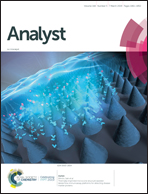A FRET-based ratiometric two-photon fluorescent probe for superoxide anion detection and imaging in living cells and tissues†
Abstract
The superoxide anion (O2˙−) plays a crucial role in several physiological processes and many human diseases. Developing new methods for O2˙− detection in biological systems is very important. A FRET-based two-photon (TP) fluorescent probe with a ratiometric signal, TFR-O, was developed. A naphthalene derivative based TP fluorescent group was selected as the energy donor group, and a rhodol fluorescent group was chosen as the energy acceptor; the trifluoromethanesulfonate group was chosen as the recognition moiety. After reacting with O2˙−, the recognition moiety was removed and the fluorophore was released, leading to a fluorescence intensity decrease at the wavelength of 425 nm and a significant enhancement of the fluorescence intensity at 550 nm. The fluorescence intensity ratio between 550 and 425 nm (I550/I425) varied from 0.15 to 6.72, with the O2˙− concentration increasing from 0 to 50 μM. The detection limit of the TFR-O was 83 nM. Moreover, TFR-O was applied for detecting and imaging O2˙− in cells and liver tissues.



 Please wait while we load your content...
Please wait while we load your content...